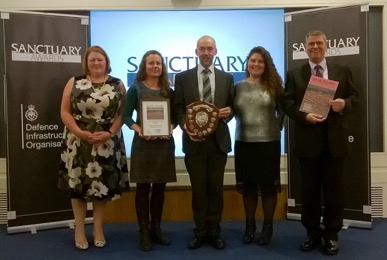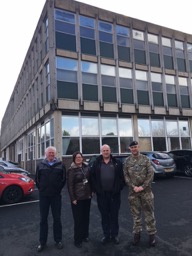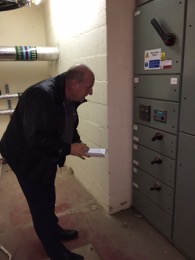Most of us probably don’t realise the real running costs of the various tools, equipment and technology support systems we use at work. The lighting, heating/cooling appliances, and other tools used by MOD staff in the office environment alone cost approximately 11p per kilowatt hour, the bills for which add up to millions of pounds each year. If you then consider the wide range of equipment we use beyond the office walls, you can begin to imagine the scale of the problem – or the potential for improvement!
![Our day-to-day work involves unavoidable electricity use. However, most of us can reduce our usage to save energy and money. [Crown Copyright/MOD2013]](https://insideDIO.blog.gov.uk/wp-content/uploads/sites/29/2017/12/45156053-1024x642.jpg)
Sanctuary Award winner
This work is a collaborative effort; Dstl staff have worked with three external suppliers (BAE Systems, Bright HF and Trimetis) through five phases of activity - Phase 5 continues as we write. As a cohort, we are delighted that this project was recognised in this year’s Sanctuary Awards as the Utilities Project Award Winner.

The work started with the basics: a literature review to identify energy behaviour change best practice and to establish the root causes of MOD energy expenditure. We then designed and distributed a survey to get an understanding of current individual and organisational levels of awareness of energy targets and initiatives. Based on these findings, we developed a step by step approach for encouraging behaviour change called Future Interventions Start Here which was given the catchy title of ‘FISH’.
How FISH works
The next phase of work involved running three case studies to validate the suitability of the FISH approach. The aim was to encourage a group of staff to make small and simple changes to reduce their energy consumption. The focus was on switching off equipment (IT and non-IT) and lighting, over a four-month period. This case study was run at Catterick Garrison in North Yorkshire.

The team worked with the Area Utility Manager and the Building Custodian on site to understand the energy issues unique to this building and the staff working there. Using this knowledge, we tailored a set of interventions and monitored their implementation for four months. The interventions included:
- Regular feedback on energy usage from the Building Custodian to the Department Heads, who then filtered the information down to staff.
- Dispelling myths – such as the fact that staff do not need to leave their computers on overnight to receive updates.
- Visual prompts – such as stickers, checklists, posters, and reminders.
Before, during and after this trial period we measured change with staff attitude and behaviour surveys, meter readings and observational audits. We are pleased to report that the trial went swimmingly! Our results showed average electrical savings of 19 per cent over the four month period, equalling financial savings for the MOD.

More importantly, we found that asking staff to make these simple changes to daily working habits resulted in both increased awareness of energy issues and changes to their behaviour which meant that they used less energy than before the case study began.
Next Steps
Our research concluded that the FISH approach is scientifically robust and easy for managers and staff to understand. The team are now working to roll out this energy saving work across the MOD. We are also developing a training course for MOD staff to share these tips for changing behaviour on a wider scale. We are looking forward to sharing our work with sites across the MOD to get staff hooked on saving energy!
2 comments
Comment by Keith D posted on
Whatever happened to the idea of spend to save? As most MOD personnel work during 'normal' working hours mostly during the daytime solar energy has to be the way forward to save on the massive electricity bills. If money could be sourced from the Government to fund solar panel installation across the Defence Estate the MOD could potentially save a fortune in the long run by reducing electricity bills with a potential to make money if there was surplus power produced that could be returned to the National Grid. I know it has been looked at, but no action appears to have been taken to further the idea. This may be a more practical way of saving money as we rely more and more on more energy hungry devices to do our work.
Comment by DIO Communications Team posted on
Hi Keith, thanks for the comment.
There are solar panels going on a number of new buildings. For example, at Worthy Down three buildings now have photovoltaic panels on the roofs, which will produce 325,917kWh/yr of electricity annually. The amount generated on the main college building alone will save the base approximately £50,000 per year.
We also installed the largest solar array in the country at MOD Lyneham. You can read more here: https://www.solarpowerportal.co.uk/news/the_government_just_completed_the_uks_largest_solar_farm_56342